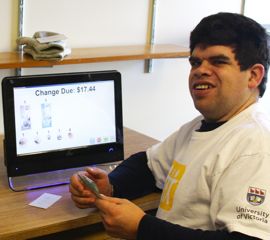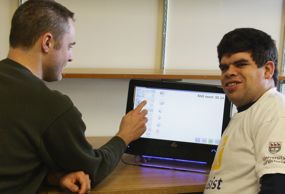Visual Money Calculator

For a young person starting a new job, using a cash register and engaging with the public can feel daunting at first; but after a short learning curve, it usually becomes manageable.
For a young person with some types of cognitive disabilities, the same challenge can be a barrier to progressing at their workplace, which might be a grocery store or retail outlet. This barrier could mean the difference between working a cash register and interacting with customers, instead of stocking shelves and cleaning aisles.
 The original idea for the Visual Money Calculator was commissioned through Jenn Reiher of Steps Forward, an organization dedicated to helping young people with cognitive impairments progress through post-secondary education and secure employment. The organization wanted a tool that could be used as a cognitive aid for clients who were working, as well as a learning tool that could prepare them for cash transactions presented in the workplace.
The original idea for the Visual Money Calculator was commissioned through Jenn Reiher of Steps Forward, an organization dedicated to helping young people with cognitive impairments progress through post-secondary education and secure employment. The organization wanted a tool that could be used as a cognitive aid for clients who were working, as well as a learning tool that could prepare them for cash transactions presented in the workplace.
CanAssist's software group developed a program that would help a person learn about currency and handle basic money transactions.
“It's a useful tool for people who are unable to convert a written currency value – let's say, $1.23 – into the actual money, which in this case would be a loonie, two dimes and three pennies,” Leo says.
The Visual Money Calculator works by displaying on a screen the three fundamental steps in a financial transaction from the point of view of the cashier: price entry, payment and change owed. A cashier can match the actual bills and coins they receive from a customer with the images of the bills and coins displayed on the screen.
Nathanael Kuipers was Leo's assistant on the project and is currently a graduate student with the CanAssist engineering team. He worked on the general layout, settings and audio implementations of the project.
“Each of the three steps in the process has its own screen in the tool. Upon completing a transaction, the interface cycles back to price entry, ready for the next transaction,” Nathanael says.
In the long run, the Visual Money Calculator presents an enormous opportunity for many people entering the workforce with special needs. Not only does it provide practical support to an employee, it also teaches a basic life skill: financial literacy. And with technology becoming increasingly mobile, the combination of the Visual Money Calculator and, for instance, the iPad, offers many possibilities.
“I love seeing the power technology has to empower people, and a tool like this has the potential to significantly open up job opportunities for people with money or math barriers,” Jenn says. “I am looking forward to seeing the different ways the money calculator will be useful.”
Go to Top